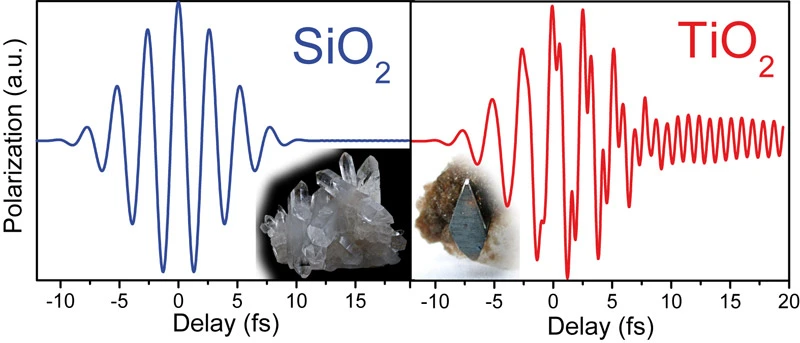Nonlinear resonance disaster in the light of ultrashort pulses
MBI scientists investigate different material responses in optical processes
Ultrashort light pulses from modern lasers enable temporal resolution of even the fastest processes in molecules or solid-state materials. For example, chemical reactions can, in principle, be traced down to the 10-fs time scale (1 femtosecond (fs) = 10-15 s). Ten femtoseconds correspond to a few oscillation cycles of the light field itself. Nevertheless, there is a class of optical processes that does not exhibit any measurable delay relative to the ultrafast light oscillation and which has been termed “instantaneous”. This class of processes includes nonlinear optical harmonic generation at multiple frequencies of the input field. This process is commonly used to generate the green light of laser pointers from invisible infrared light. These processes are normally used far away from a resonance to avoid losses.
In a collaborative effort, researchers of the Max-Born-Institut, the Weierstraß-Institut as well as the Leibniz-Universität Hannover now experimentally demonstrated for the first time that conditions exist where optical harmonic generation becomes non-instantaneous. Analyzing third-harmonic generation in titanium dioxide thin films, a lifetime of 8 fs was found, i.e., non-instantaneous behavior. Nevertheless, this process still qualifies as one of the fastest processes ever resolved with femtosecond spectroscopy.
Detailed theoretical modeling of these surprising findings indicates that this non-instantaneous response may only occur if there is a resonance of the third harmonic in the optical material. In turn, the generated material response persists to oscillate several cycles after the excitation has already ceased. Concomitantly, third-harmonic radiation is emitted. The process therefore appears like an atomic “resonance disaster”. Similar to mechanical oscillators, this atomic system therefore shows a non-instantaneous behavior.
These findings have important consequences for femtosecond measurement techniques and possibly also for ultrashort-pulse generation. These methods have always relied on an instantaneous nature of harmonic generation and related effects. Similar to soldiers who avoid marching in step on a suspension bridge, one therefore also has to carefully avoid optical resonances when measuring extremely short laser pulses.
Original publication:
Michael Hofmann, Janne Hyyti, Simon Birkholz, Martin Bock, Susanta K. Das, Rüdiger Grunwald, Mathias Hoffmann, Tamas Nagy, Ayhan Demircan, Marco Jupé, Detlev Ristau, Uwe Morgner, Carsten Brée, Michael Woerner, Thomas Elsaesser, Guenter Steinmeyer
Noninstantaneous polarization dynamics in dielectric media
OPTICA doi.org/10.1364/OPTICA.2.000151
Figure: Reaction of SiO2 and TiO2 to a short pulsed light field. In SiO2 the displacement of electron shell and nuclei follows the exciting electric field. Immediately after the end of the pulse, this oscillation ceases, too. In contrast, in TiO2, an oscillation build-up is observed at the third harmonic of the exciting field. This oscillation continues beyond the end of the pulse. Insets show pictures of crystalline modifications for both optical materials.
Animation (AVI): Reaction of SiO2 and TiO2 to a short pulsed light field. The electric field is visualized by the central arrow. The resulting displacement of the center of the electron shell relative to the position of the nucleus is shown in a simple atomic picture for both materials. Third-harmonic emission is indicated by a blue color of the shell. In SiO2, both the resulting oscillation as well as the harmonic emission immediately cease after the end of the exciting pulse. In contrast, TiO2 exhibits a resonant build-up of the third-harmonic oscillation, which persists beyond the duration of the exciting pulse.
Contact:
Dr. Günter Steinmeyer
Max-Born-Institut
Tel.: 030 6392-1440
Email: bredtman(at)mbi-berlin.de
